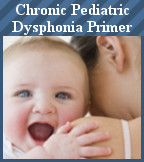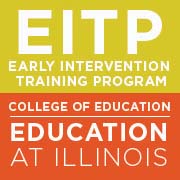Dysphonia, or hoarseness, - but which can also mean any voice quality that is breathy, strained, fatigued, rough, tremulous, weak, having a change in pitch or abnormal resonance, such as an abnormal cry - is common in children and often result in pediatric visits. The Hoarseness can be caused by any process that affects the structure or function of the larynx.
While in the past, it was of less than two weeks duration and stemmed from more than simple upper viral respiratory laryngitis, today it is on the rise as a chronic condition of greater than two weeks duration and increasingly on the rise. More commonly present than in the past, dysphonia may occur in babies - for a pathognomic trifecta of reasons, thought to be explained by a triple risk paradigm of infant colic, infant obesity, and GERD, the latter two of which are modern and recent health dangers to babies. The presence of the caustic effects GERD will exacerbate screamer’s nodules; similarly, the prolonged screaming from colic will aggravate nodules on vocal folds resulting from GERD, thereby exacerbating hoarseness in a vicious cycle of worsening and trauma for the infant.
The link between obesity and GERD, already established in adults, is thought to be operative in infants and children. Although the exact prevalence is unknown, it is estimated that nearly 1 in 5 children likely suffers from reflux disease; although controversial – less so if they have symptoms of GERD, many of these children show relief when treated with medications.
- What is happening to babies during the 21st century? Why are so many more suffering from reflux? Why are so many suffering from obesity? Is there a connection of these two to a particular type of hoarseness that is more prevalent? These questions will be explored in the context of this course on chronic pediatric dysphonia and its management.
For the early intervention speech provider of care, it is critical to know the dangers of the contributors toward what might appear as a simple problem of hoarseness and treat that problem without addressing – via parent education - the etiology of factors that may heighten the likelihood of developing dysphonia in the first place. Given the unique responsibility of the speech language pathologist’s entry into the sanctity and privacy of the new born or infant, a special responsibility lies with her/him to know and share the etiology of those factors contributing to dysphonia in this unique setting, and address its root causes with prevention, as professional imperative, and most certainly within the bounds of their professional practice act.
In addition to the requisite exposition which lays the framework toward an understanding of this complex issue and its prevention and treatment, the didactic method includes all the relative anatomy, kinesiology, neuroanatomy of the larynx, which is directly relative to any thorough discussion and understanding of laryngeal dysfunction is general and dysphonia in particular.
This primer is a MUST READ for all early intervention and pre-school therapists who service the professional needs of the infant, toddler, and child with Chronic Pediatric Dysphonia.
Sign up now!

This program is offered for 0.50 ASHA CEU's (Level: Various Content Code: Professional)
ASHA LEARNERS PLEASE NOTE: There are 2 purchase options above, EI Continuing Education and CEU. If you wish to earn ASHA CEUs for this course and you select the CEU option, your information including name, address, e mail and ASHA ID, will be sent to ASHA CE. If you do not want your information sent to ASHA, please select the option for continuing education. Learner must achieve a passing score of 75% on the post course examination in order to meet satisfactory completion requirements.

EITTOC is an AOTA Approved Provider of professional development. Course approval ID# 8922. This distance learning-independent is offered at 0.5 CEUs, introductory, OT service delivery/foundational knowledge. The assignment of AOTA CEUs does not imply endorsement of specific course content, products, or clinical procedures by AOTA or indicate AOTA approval of a certification or other professional recognition.
APPROVED BY THE ILLINOIS EARLY INTERVENTION TRAINING PROGRAM FOR EARLY INTERVENTION CREDENTIAL CREDIT for 5.0 Hours
Disclosure: Disclosure: David C Saidoff PT - course developer/presenter - has the following relevant financial relationships to disclose: he receives monetary compensation for the preparation of this course, in addition to a percentage of company sales, and has the following relevant non-financial relationships to disclose: EITTOC Board of Directors: volunteer member. Melissa Whelan, OTR - course developer/presenter - has the following relevant financial relationships to disclose: she receives monetary compensation for the preparation of this course, in addition to a percentage of company sales, and has the following relevant non-financial relationships to disclose: EITTOC Board of Directors: volunteer member. KristenO’Leary,SLP, has the following relevant financial relationships to disclose: she receives monetary compensation for the preparation of this course, in addition to a percentage of company sales, and has the following relevant non-financial relationships to disclose:EITTOC Board of Directors: volunteer member. Dr. Robert Koppel, M.D.,FAAP, Diplomate of the American Board of Pediatrics has the following relevant financial relationships to disclose: he receives monetary compensation for the preparation of this course, in addition to a percentage of company sales, and has the following relevant non-financial relationships to disclose: EITTOC Board of Directors: volunteer member. Dr. Robert Koppel, M.D.,FAAP, Diplomate of the American Board of Pediatrics has the following relevant financial relationships to disclose: he receives monetary compensation for the preparation of this course, in addition to a percentage of company sales, and has the following relevant non-financial relationships to disclose: EITTOC Board of Directors: volunteer member. Declaration: Approval of this course does not necessarily imply that any of the governing bodies (e.g., West Virginian Board of Physical Therapy, or other such governmental or NGO’s supports the views of the presenter or sponsor. Information provided should be used within the scope of practice. No relevant financial or non-financial relationships exists between EITTOC or the products discussed any course; no such relationship or endorsement exists for any products mentioned in any courses sponsored by EITTOC, or in any of the items (such as specific AED or Epinephrine injection product) or any testing instrument used to evaluate children; the above course is specific to said-topic, and may not be extrapolated to any other course or topic outside the scope of this course. Course instructor(s) have no other financial or non-financial remuneration - whether prior to or following course delivery; the above advertisement is made available to all physical therapy (and other) licensee on a non-discriminatory basis. Ascend has approved this course and may be contacted about any concerns. Information provided should be used within scope of practice. AOTA does not endorse specific course content, products, or clinical procedures. The onus of responsibility for this course – granted contact hours by the AOTA – is for each OT professional to check with their State board of OT to see if this course meets licensure requirement for continuing education. |









